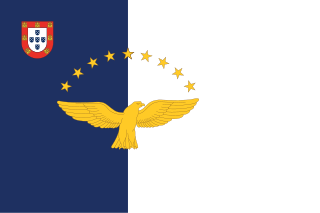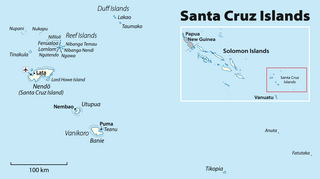Related Research Articles

The Azores, officially the Autonomous Region of the Azores, is one of the two autonomous regions of Portugal. It is an archipelago composed of nine volcanic islands in the Macaronesia region of the North Atlantic Ocean, about 1,400 km (870 mi) west of Lisbon, about 1,500 km (930 mi) northwest of Morocco, and about 1,930 km (1,200 mi) southeast of Newfoundland, Canada.
Guadalupe or Guadeloupe may refer to:

The Santa Cruz Islands are a group of islands in the Pacific Ocean, part of Temotu Province of the nation of Solomon Islands. They lie approximately 250 miles (400 km) to the southeast of the Solomon Islands archipelago. The Santa Cruz Islands lie just north of the archipelago of Vanuatu, and are considered part of the Vanuatu rain forests ecoregion.

The Angra do Heroísmo Football Association is one of the 22 District Football Associations that are affiliated with the Portuguese Football Federation. The AF Angra do Heroísmo administers lower-tier football in the municipalities on the islands of Terceira, São Jorge, and Graciosa, within the Portuguese archipelago of the Azores.

Santa Cruz da Graciosa is a Portuguese municipality on the island of Graciosa, in the archipelago of the Azores. The population in 2011 was 4,391, in an area of 60.66 km². It includes four local parishes and one municipal government structure, which administers the entire island.

Graciosa Island is referred to as the White Island, the northernmost of the Central Group of islands in the Azores. The ovular Portuguese island has an area of 60.65 square kilometres, a length of 10 kilometres and a width of 7 kilometres. It is a volcanic island, dominated by a 1.6-kilometre-wide (1.0-mile) central caldera located in the southeast.

Graciosa Island or commonly La Graciosa is a volcanic island in the Canary Islands of Spain, located 2 km (1.2 mi) north of the island of Lanzarote across the Strait of El Río. It was formed by the Canary hotspot. The island is part of the Chinijo Archipelago and the Chinijo Archipelago Natural Park. It is administrated by the municipality of Teguise. In 2018 La Graciosa officially became the eighth Canary Island. Before then, the island had the status of an islet, administratively dependent on the island of Lanzarote. The only two settlements on the island are Caleta de Sebo in the southeastern part of the island and summer-residence Casas de Pedro Barba.

Teguise is a municipality in the central part of the island of Lanzarote in the Las Palmas province in the Canary Islands. The population is 22,342, and the area is 263.98 km². It is located north of Arrecife and south of Haría. The seat of the municipality is the town of Teguise. The municipality also comprises a number of neighbouring islands including Graciosa, Alegranza, Roque del Este, Roque del Oeste and Montaña Clara.

Graciosa and Percinet is a French literary fairy tale by Madame d'Aulnoy. Andrew Lang included it in The Red Fairy Book.

Caleta de Sebo is the main settlement and capital community of La Graciosa, Canary Islands.

Graciosa Airport is an airport located 2 km (1.2 mi) west northwest of Santa Cruz da Graciosa on Graciosa Island in the Azores.

The Canarian shrew is a species of mammal in the family Soricidae. It is endemic to the Canary Islands, specifically the eastern islands of Lanzarote, Fuerteventura, Lobos, and Mount Clara. It used to be found on Graciosa, Canary Islands and Alegranza. Its natural habitat is subtropical or tropical dry shrubland. It is threatened by habitat loss.

Daniel Muñoz de la Nava is a Spanish professional tennis player. He reached the quarterfinals of Estoril in 2012 and Delray Beach in 2013, both as a qualifier.

The Graciosa fortress was established on the coast of Morocco by the Portuguese in 1489. It was established on a small river island, about three leagues from the sea, at the junction of river Lucus and river el-Mekhazen, a few kilometers inland from modern Larache. The island had been yielded to the Portuguese by Abu Zakariya Muhammad al-Saih al-Mahdi through a treaty following the Portuguese capture of Arzila.
Vasco Gil Sodré was a Portuguese navigator and one of the first settlers of the island of Graciosa. Although he attempted to obtain the Donatary captaincy of the island, he and his progenitors were the origin of many of the families of the island.

The Burro da Ilha Graciosa or Burro Anão da Graciosa is a breed of small domestic donkey endemic to the island of Graciosa, in the North Atlantic archipelago of the Azores, which are an autonomous region of Portugal. It is critically endangered, but is not officially recognised or reported to the DAD-IS database of the FAO. Efforts are being made to obtain official recognition and protection of the breed.

Pterolophia is a genus of longhorn beetles of the subfamily Lamiinae, containing the following species:

The Central Group is one of the island groups of the Azores, Portugal. It comprises the islands of Pico, Terceira, São Jorge, Faial and Graciosa.
References
- ↑ BioLib.cz - Pterolophia graciosa. Retrieved on 8 September 2014.